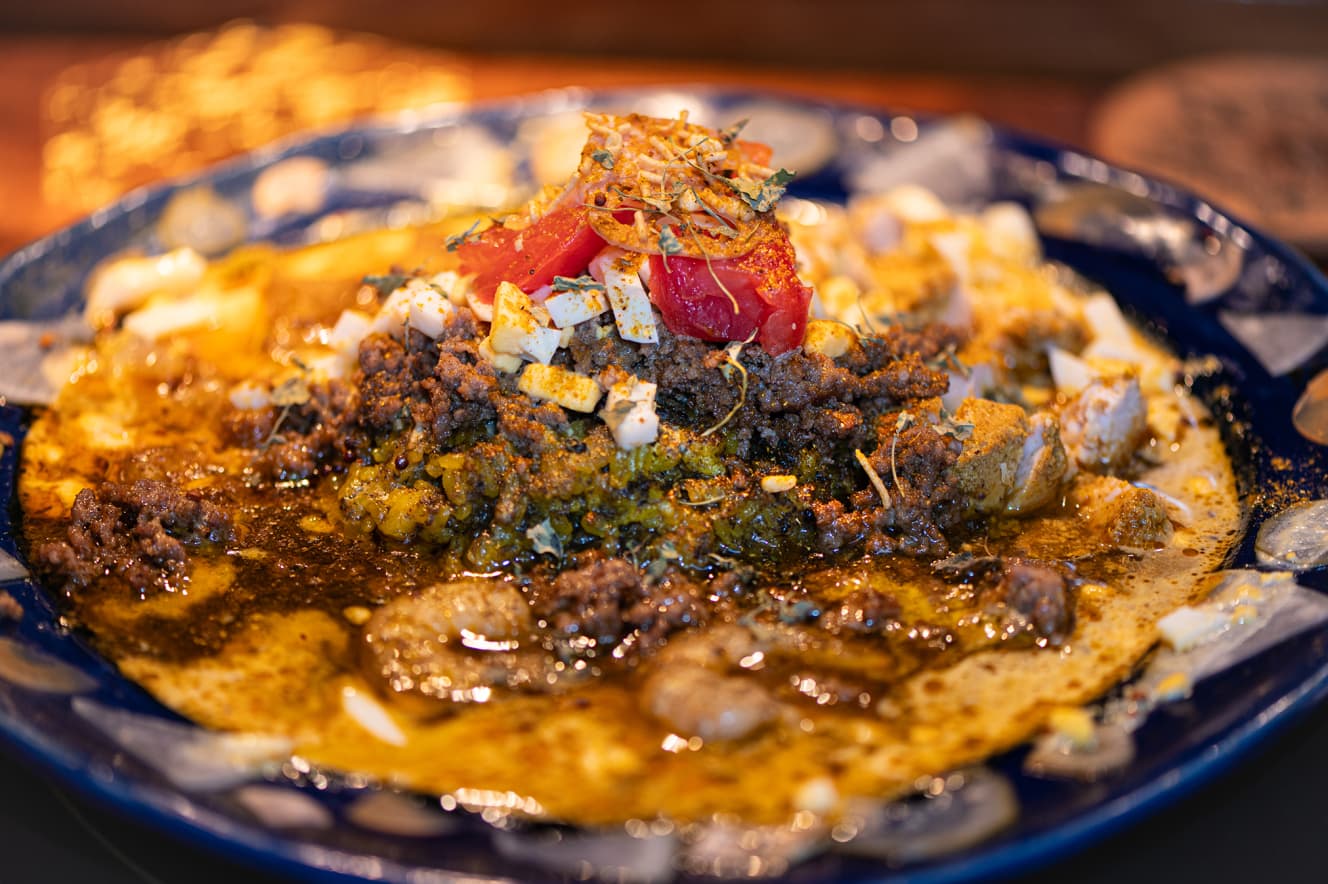Naoki Matayoshi visited the restaurant and said, “I learned a lot…” Reason why spice curry restaurants with prices in the 2,000 yen per dish range are trying to go upscale even further.

I ordered the “3 kinds of 3-top honey keema (4 kinds)” (2,800 yen), the most recommended dish at this restaurant.
A few minutes of waiting followed my order. What appeared was a deep navy blue platter of three spiced curries, topped with three different toppings and honey keema, colorfully garnished. If you thought it was a picture of a plate, you’d be surprised at how boldly pickled cucumbers (green), carrots (red), radishes (white), and eggplant (purple) were arranged on the edge of the plate.
A spoonful is scooped into the mouth, and the spicy flavor is juicy, sour, and delicious. The spiciness of the salsa tomatoes, the sweetness of the tartar egg and potato salad, and the mild, not spicy, juicy flavor of the honey keema mixed together to create a deep flavor that spread in my mouth.
The chicken is the standard,” he said. The other two meats are irregular, with beef, pork, seafood, shrimp, and before the rainy season, firefly squid, depending on what we have in stock that day.
Mr. Okano’s idea of “upscale” curry
Why does he select and serve not popular spiced curry, but carefully selected ingredients that are 1.5 to 3 times more expensive?
Mr. Okano says, “I think there are many customers who feel that ‘spiced curry makes me sweat, is spicy and tasty, but after eating it, I get tired and thirsty.’ In 23 years, the price is still 1,500 yen, so there is no way around it, but I wanted to change that “B-grade gourmet atmosphere.
If you look at it from a broader perspective, for example, high-class French restaurants and sushi restaurants have a strong food culture, and there are many customers who can comfortably pay 20,000 to 30,000 yen even for lunch…. We believe that if we can first make these customers deeply aware of our concept, we will be able to capture a large share of the market.
We believe that the affluent customers are looking forward to spiced curry with such a strong focus.
In fact, I prepare curry by myself more than 350 days a year, but because I make the broth from scratch, I can only prepare 5,000 servings a year. If we can use this as an advantage and steadily build up a core fan base of about 500 people who visit our restaurant once a month, we will be able to sell out our curry. All we had to do was market to them patiently.
Mr. Okano has certain ambitions for his spiced curry.
The price of curry at our restaurant starts at 2,200 yen, but depending on the rate of price increases, we will raise the price in stages, and my dream is to be able to offer curry for 5,000 yen or more by 2030. In other words, I would like to grow together with our customers who are willing to pay 5,000 yen for curry for lunch.
I am optimistic that developing a high-end line of spiced curry is rather a blue ocean (opportunity) since there is no competition yet.
If we can launch a high-end culture of “luxury spice,” we can leave behind a world where young chefs in their 20s and 30s who will live in the 2030s can drive a Lexus and live in a tower apartment, even if they are spice curry chefs.
I want to keep a place where I can offer the real thing to the younger generation. This is my romance.”
Mr. Okano stands in his store more than 350 days a year and never rests. Will his insatiable passion be able to break the common sense of spiced curry and elevate the culture to luxury spice in the near future? Today, in the kitchen, the chef’s challenge continues.





Photographed by: Shoko Sugiura (1st, 3rd, 4th, and 5th pictures)